 Etymology: from Latin "Pinus"; Indo-European "Peak" = "bitter". Etymology: from Latin "Pinus"; Indo-European "Peak" = "bitter".
Origin: the indigenous species met in France are the Maritime pine, Pinus pinaster (native to Western Mediterranea), the Scotch Pine or common Pine, the Umbrella Pine, Pinus pinea (characteristic form, in umbrella, native to the Mediterranean periphery), the laricio Pine of Corsican (and from Italy), the Pine Cembro (native to the Alps and of the Carpathianses), the Pine of Alep (native to the Mediterranean periphery) and the Pine with hooks (native to the Alps and of the Pyrenees). The maritime, Scotch and Alep pines cover about 20 % French forests (see the distribution map of the French forest). Three European pines are also planted: the Austrian Pine, native to the centre of Europe, the Macedonia pine, native to Albania, and the mountain pine, smaller than other pines, native to the mountains of Central Europe.
Not European species: very many (from America, from China, from Japan).
Maximum sizes: 15 m (Pine of Alep), 25 m (Swiss Mountain Pine), 30 m (Umbrella Pine), 35 m (maritime and sylvan Pines), 45 m (laricio Pine).
Form and trunk: Pines raise a straight trunk, which supports a graduated and broad crown. The low branches die and fall, clearing the trunk. The Maritime pine is different from its close cousins, Austrian Pine and Scotch Pine, by its trunk twisted by places (and its pink-orange bark at the top). Planted tight (forest of Landes), Maritime pines stretch more and their trunk is perfectly straight.
The black Pine of Salzmann often has a sinuous trunk.
The Umbrella Pine distinguishes itself by a right and bare trunk on the lower two thirds and a rounded crown, ball or domed.
Bark: The bark of most Pines sheds in scales. The bark of the Umbrella Pine is brown ruddy with grey nuances. That of the Maritime pine is thick, red-purple. That of the Scotch Pine is brown ruddy on the bottom of the trunk, ferruginous red on the top.
Habitat: the Scotch Pine, Pinus sylvestris (above) is a tree of light, accepting the poor, acid soils. It is a pioneer species, that is capable of fitting on a soil lacking in vegetation. Its needles decompose badly in the soil and prevent the development of the undergrowth. It supports cool climates and it is met in the North of France.
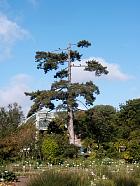 Maritime pine, Pinus pinaster: it prefers the not calcareous fields. It is the pine typical of Landes (reforestation in the XIXth century).
Maritime pine, Pinus pinaster: it prefers the not calcareous fields. It is the pine typical of Landes (reforestation in the XIXth century).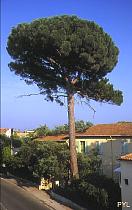 It is met in the South of France and very occasionally more in the north. It is met in the South of France and very occasionally more in the north.
Umbrella pine, Pinus pinea (to the right): it is met on the Mediterranean coast. It is emblem of the Italian peninsula.
Laricio pine: pine of Mediterranean regions, it supports the climate of the Paris region (nice tree planted by Jussieu, in 1784, in the Garden of plants, to the left). It supports pollution.
Leaves: needles grouped in fascicles from 2 to 5. Clustered, they form a cylinder; their cross-section is a semicircle for needles grouped by two (the most frequent case). The base of needles carries a bundle sheath, which falls generally in next autumn. Needles persist 3 - 5 years (4 - 6 to the umbrella pine). The length of needles varies from 3 to 20 cm (see below), the longest being those of the black Pine of Salzmann (which is rather rare).
Flowers: Pines are trees monoecious, that is to say the male and female flowers of which are carried by the same foot. Inflorescences are catkins, the male located at the top of the twig where the wind has most action to disseminate the pollen. The female inflorescence is standing aside, more discreet. The dispersion of the pollen, in spring, such a "sulphur rain", covers the neighbourhood of a yellow powder (visible on vehicles, or in the streaming zones after a rain). Some persons are allergic.
Fruits: the female inflorescence, once the accomplished fertilization, matures in two (seldom three) years and forms a cone. This one is orientated downward (falling), unlike the cone of the fir. It opens in autumn (cone dehiscent) and liberates winged seeds. Some pines, like the maritime pine, liberate seeds when they are subjected to the heat of a fire. The wildfire, notably in some North American forests (ex: Anthony's pine), is a chance to regenerate the forest, by destroying intrusive species, and by liberating the seeds which have remained locked for decades. In planted forests, fires are a threat to the contrary. The seeds are usually winged, which facilitates their spread by wind and the extension of the range.
Legends and traditions: In Greek mythology, the nymph Pithys, coveted by Pan, escapedby transforming into black Pine. In the Isthmic Games, from Corinth, it is pine crowns that rewarded the victors. In The Middle Ages, the chivalry novel links it to knowledge and to immortality (ex: Roland's song). The Pine fills Yvain with wonder in the Roman de la Rose. Béroul, in Tristan and Yseut, places the pine in the garden where the heroes meet and the king hides in the pine to spy the meeting.
>>> Read also the poem which Pierre Ronsard dedicated to it and, for the pine of the Landes, the poem of Theophile Gautier.
Uses: from the resin of maritime pine, the Greeks and the Romans extracted the pitch, balsams and some spices, of which "Crapula", to perfume the wine. One always picks up the turpentine and pitch, caulking (which was used to seal the hulls of boats - one says "caulk") and a comparable gasoline incense. The maritime pine was widely planted in the Landes, to stabilize the swampy ground, and subsequently to provide the paper mills. Many experiments have been launched in the Landes to fix sand dunes and dry wetlands: Father Louis Desbey, canon at Bordeaux and his brother William, collector of farms in La Teste, recommend in 1774, to fix the dunes with faggots wicker fences, planting of marram grass and brooms which would shelter from winds the plantations of maritime pines. The engineer of Roads and Bridges Nicolas Brémontier
continues to work successfully in 1786, not only on the dunes, but also in the marsh, after draining the water in the canals. Napoleon I and Napoleon III later promote those projects which are considered to be completed in 1876 (it took 100 years).
Wood, although softwood is also used in joinery, carpentry, paper pulp, fiberboard.
As fuel, Scotch pine is better fuel than the spruce, fir or larch. It was used in blast furnaces for reducing Minerals. It's the resin which facilitates combustion and makes the pines dangerous for domestic chimneys (soot, may fire).
The umbrella pine produces seeds that are edible, they are called sprockets popular in salads.
Scots pine needles were used to make a cotton that they succeeded in spinning to produce a fabric resembling flannel.
Advices of maintenance: at the end of summer, watch the appearance of the red spiders on the conifers which, then, turn yellow. Water the foliage copiously in the clear water in prevention or deal with an acaricide |
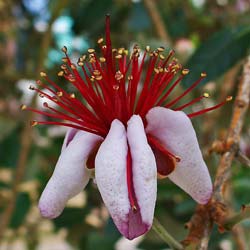
![]()
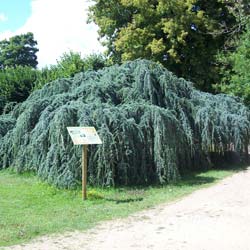
![]()
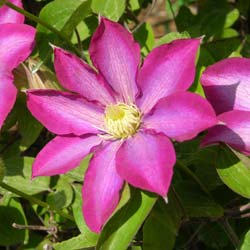
![]()
 Etymology: from Latin "Pinus"; Indo-European "Peak" = "bitter".
Etymology: from Latin "Pinus"; Indo-European "Peak" = "bitter".